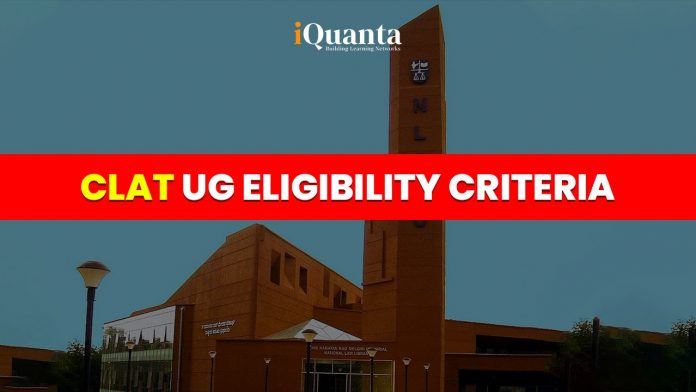In this article, we will discuss the CLAT exam’s Eligibility Criteria for the year 2026, the minimum percentage required, and the minimum age limit for the CLAT exam.
The Common Law Admission Test (CLAT) is an after 12th exam conducted by the Consortium of NLUs for admissions into various National Law Universities (NLUs). There are a total of 26 NLUs in India out of which only 24 NLUs accept the score of the CLAT exam. The Consortium will soon announce the CLAT eligibility for the year 2026 on its website. Currently, no changes are expected in the CLAT 2026 eligibility criteria.
It is important for the CLAT aspirants to go through the CLAT eligibility criteria in a detailed manner before applying for the exam. These criteria ensure that candidates meet the required academic qualifications and other requirements for the admission in the NLUs. If any candidate is failing to meet the CLAT eligibility criteria then it leads to the disqualification at later stages, so it is recommended to the aspirant to go through the instructions properly. Hence, checking for the latest eligibility criteria for CLAT 2026 on the official website. First, let’s discuss the exam pattern of CLAT:-
CLAT 2026 Eligibility and Syllabus
Before we dive into the CLAT Eligibility Criteria, let’s discuss its exam pattern. The CLAT 2026 exam is divided into five sections and each section has a different weightage in the CLAT 2026 exam. There are 120 questions in total out of which GK and the Legal Reasoning section hold the highest weightage of 25% each in the CLAT exam.
Understanding the CLAT exam pattern is one of the important parts of your preparation but being aware about the CLAT eligibility criteria is equally important. The Consortium of NLUs describes the academic qualifications and other requirements that CLAT aspirants must check with to appear for the exam. So, whether you are a class 12th student or a reappearing candidate, make sure you meet the CLAT eligibility norms to avoid disqualification at the later stage of the NLU admission process.
We have mentioned CLAT Eligibility and Syllabus below, The following are the subjects and their sectional weightage in the CLAT exam:-
For detailed CLAT UG 2026 Syllabus, visit CLAT Syllabus.
| Section | CLAT Subjects | Weightage of the section | No. of Questions |
| 1 | English Language | 20% | 22-26 |
| 2 | Current Affairs/General Knowledge | 25% | 28-32 |
| 3 | Legal Reasoning | 25% | 28-32 |
| 4 | Logical Reasoning | 20% | 22-26 |
| 5 | Quantitative Aptitude | 10% | 10-14 |
| Total | 100% | 120 |
CLAT Age Eligibility Criteria 2026
The first thing a candidate should know is whether they meet the eligibility criteria: age of the CLAT exam which is set by the Consortium of NLUs.
Maximum Age Limit: There’s no upper age limit in the CLAT exam, which implies that there’s no upper cap on the maximum age of a candidate in the CLAT exam. The Bar Council of India lifted the age limitation as per the directions of the Supreme Court.
Minimum Age Limit: Students who have passed class 12th and or will be appearing for the same will be eligible for this exam.
| Category | Age Limit | Description |
| General/OBC/SC/ST | No upper age limit | There is no restriction on the upper age for CLAT UG or PG exams |
| Minimum Age | No fixed lower age | However, candidates must have cleared Class 12 (for UG) or LLB (for PG) at the time of admission |
If you are looking for a structured CLAT preparation along with 24*7 doubt-solving, you can rely on the iQuanta CLAT Online Coaching.
Minimum Percentage and Minimum Eligibility for CLAT UG 2026
The following are the minimum CLAT eligibility criteria, you need to secure the following percentage in your class 12th examination:-
- You must secure at least 45%, in case you belong to either General/OBC/PWD/NRI/PIO/OCI categories, overall in your class 12th or equivalent examination.
- You must secure at least 40%, in case you belong to SC/ST categories, overall in your class 12th or equivalent examination.
- Candidates who may be appearing for their qualifying examination in March/April are also eligible to appear for the CLAT 2026 examination. However, they shall be required to produce evidence of their passing the qualifying examination at the time of admission, failing which they shall lose their right to be considered for admission.
Also Read: NLU Placements for a detailed placement report of all the NLUs.
CLAT Eligibility Criteria for NRI Students
The NRI candidates willing to go for the CLAT exam should check their CLAT Eligibility Criteria from the University authorities. Admissions to NLU are done based on the merit score of the NRI candidates. The Consortium’s office will be responsible for issuing the list of eligible NRI Candidates.
Also Read: How to prepare for CLAT
CLAT Eligibility for Integrated Law Programs
Integrated law programs such as B.A. LL.B. (Hons), B.B.A. LL. B., B.Com LL.B.,and B.Sc LL.B. are offered by various NLUs through CLAT UG exam. While the core CLAT eligibility criteria like minimum educational qualification that is passing of class 12th and minimum percentage criteria remain the same across these courses, some NLUs prefer specific subject combinations in class 12 and especially for the courses like B.Com LL.B or B.Sc LL.B. It is very important for aspirants to understand the CLAT eligibility criteria that is associated with the preferred law program to ensure accurate application and avoid any kind of disruptions during the counselling process.
| Integrated Law Programs | Common Subjects in Class 12 Preferred | Minimum Educational Qualification | Minimum Marks (General/OBC/EWS) | Minimum Marks (SC/ST) |
| B.A. LL.B. (Hons.) | Any stream (Arts/Commerce/Science) | Class 12 or equivalent | 45% | 40% |
| B.B.A. LL.B. (Hons.) | Commerce or any stream | Class 12 or equivalent | 45% | 40% |
| B.Com LL.B. (Hons.) | Commerce preferred | Class 12 or equivalent | 45% | 40% |
| B.Sc LL.B. (Hons.) | Science (Physics/Chemistry/Biology) | Class 12 or equivalent | 45% | 40% |
CLAT UG 2026 Tie-Breaking Rules
The candidates who scored the same marks in CLAT UG 2026 will be allotted based on the following preference:-
(i) Higher marks in the CLAT Legal Reasoning section. and/or
(ii) Higher age preference.
Also Read: How to prepare for AILET exam
Who can apply for CLAT UG 2026?
The candidates who want to pursue law as a career at a National Law University have to take the CLAT UG 2026. The aspiring candidates should meet the following CLAT Eligibility Criteria 2026:-
- The candidates must be either in class 12th or have completed it.
- The candidate must be either an Indian citizen or Non-Resident Indian (NRI), an Overseas Citizens of India (OCI), or a Person of Indian Origin (PIO) to be eligible for the CLAT UG 2026 exam.
- The NRI candidates have to follow a different set of guidelines laid down by the Consortium.
- Foreign Nationals cannot appear for the CLAT UG 2026 exam.
- There’s no upper age limit in the CLAT exam.
- The candidates must have scored either 45% (if the candidate belongs to General/OBC/PWD/NRI/PIO/OCI) or 40% (if the candidate belongs to SC/ST categories).
Also Read: CLAT Books, best books for CLAT exam.
CLAT Eligibility vs AILET Eligibility Key Differences
Both CLAT and AILET serve as a door to the top law institutes in India. The CLAT eligibility criteria apply to the NLUs and require candidates to have passed class 12 with a minimum of 45% marks for General/OBC/EWS categories and 40% for SC/ST category. AILET, on the other hand, is noted for National Law University, Delhi (NLU-D) and follows similar academic requirements. Additionally the CLAT eligibility criteria apply to a wide range of integrated and postgraduate law programs, whereas AILET has a little focus. Candidates must carefully review the CLAT eligibility criteria and compare them with AILET to ensure that they meet the specific requirements of their target law school.
| Criteria | CLAT Eligibility | AILET Eligibility |
| Conducting Body | Consortium of NLUs | National Law University, Delhi (NLU Delhi) |
| Courses Offered | UG & PG Law Programs in 24 NLUs | UG & PG Law Programs in NLU Delhi only |
| Educational Qualification (UG) | Must have passed or appearing in Class 12 or equivalent | Must have passed or appearing in Class 12 or equivalent |
| Minimum Percentage (UG) | 45% (General/OBC/PwD/NRI/PIO/OCI) 40% (SC/ST) | 45% (General/OBC) 40% (SC/ST/PwD) |
| Educational Qualification (PG) | LL.B. or equivalent with 50% marks (45% for SC/ST) | LL.B. or equivalent with 50% marks (45% for SC/ST/PwD) |
| Age Limit (UG & PG) | No upper age limit | No upper age limit |
| Nationality | Indian Nationals, NRIs, PIOs, OCIs, and some foreign nationals (varies by NLU) | Indian Nationals and foreign nationals (foreign nationals need not appear for AILET) |
| Reservation Policy | Varies by NLU; includes domicile, SC/ST/OBC/EWS, PwD, etc. | Applicable as per NLU Delhi’s reservation policy (includes Delhi domicile quota) |
CLAT Eligibility Trends Over the Years
| Year | Eligibility Criteria |
| Before 2015 | Upper age limit: 20 years (General) 22 years (SC/ST) |
| 2015 | Same as previous year |
| 2017 | Age limit upheld as per previous rules |
| 2018 | Age limit removed temporarily |
| 2019 | No upper age limit |
| 2020 | Minimum qualification: 45% (General/OBC/PwD/NRI/PIO/OCI), 40% (SC/ST) in 10+2 |
| 2022 | No upper age limit continued Class 12 appearing candidates allowed |
| 2024 | No change |
| 2026 (Expected) | No upper age limit Minimum marks: 45% (General/OBC/PwD/NRI), 40% (SC/ST) Class 12 appearing students eligible |
CLAT 2026 Eligibility Criteria for PG Programs
The Eligibility Criteria for the CLAT PG Exam is:-
- The aspiring candidates should have a degree in law with a minimum of 50% aggregate.
- The candidates who will be appearing for the qualifying exam in March 2024 will also be eligible for the CLAT PG 2025 exam. However, the students will have to produce evidence of passing during the time of admission to their respective allotted NLUs.
Also read: Top Law Entrance Exams in India.
CLAT Eligibility for Droppers and Repeater Candidates
| Criteria | Details |
| Eligibility Status | Fully eligible to appear for CLAT UG or PG exams |
| Upper Age Limit | No upper age limit for CLAT UG or PG (applies to all candidates) |
| Minimum Qualification (UG) | Must have passed Class 12 with at least: • 45% (General/OBC/PwD/NRI/PIO/OCI) • 40% (SC/ST) |
| Minimum Qualification (PG) | Must hold an LL.B. degree with: • 50% (General) • 45% (SC/ST) |
| Year of Passing | No restriction on year of passing 12th or LL.B., as long as minimum marks are met |
| Documents Required | Original marksheets, identity proof, category certificate (if applicable), and other documents during counselling |
| Reattempts Allowed | Unlimited attempts permitted for CLAT UG/PG |
| Additional Notes | Dropper/repeater candidates must ensure that they meet all eligibility norms and have valid documentation during admission |
Top National Law Universities in CLAT UG 2026
As all of you might have understood the CLAT Eligibility Criteria of the year 2026 is, now let’s know what are the top NLUs in the CLAT exam. The following are the top National Law Universities in the CLAT exam. The colleges have been ranked based on their reviews and the National Institutional Rankings Framework (NIRF) Rankings.
For detailed information about these colleges like placements and rankings visit Top CLAT Colleges.
| S.No. | NLUs Name | Location |
| 1 | NLSIU | Bengaluru, Karnataka |
| 2 | NALSAR | Hyderabad, Telangana |
| 3 | WBNUJS | Kolkata, West Bengal |
| 4 | NLIU | Bhopal, Madhya Pradesh |
| 5 | NLUJ | Jodhpur, Rajasthan |
| 6 | HNLU | Raipur, Chhattisgarh |
| 7 | GNLU | Gandhinagar, Gujarat |
| 8 | RGNUL | Patiala, Punjab |
| 9 | CNLU | Patna, Bihar |
| 10 | NUALS | Kochi, Kerala |
| 11 | RMLNLU | Lucknow, Uttar Pradesh |
| 12 | NLUO | Cuttack, Odisha |
| 13 | NUSRL | Ranchi, Jharkhand |
| 14 | NLUJA | Guwahati, Assam |
| 15 | DSNLU | Visakhapatnam, Andhra Pradesh |
| 16 | TNNLU | Tiruchirappalli, Tamil Nadu |
| 17 | MNLU | Mumbai, Maharashtra |
| 18 | MNLU | Nagpur, Maharashtra |
| 19 | MNLU | Aurangabad, Maharashtra |
| 20 | HPNLU | Shimla, Himachal Pradesh |
| 21 | DNLU | Jabalpur, Madhya Pradesh |
| 22 | DBRANLU | Sonipat, Haryana |
| 23 | NLUT | Agartala, Tripura |
| 24 | GNLU Silvassa Campus | Silvassa, Dadra and Nagar Haveli (Not independent) |
| 25 | NLU Meghalaya | Shillong, Meghalaya |
| 26 | NLU Uttarakhand (Tentative/Upcoming) | Dehradun, Uttarakhand (Yet to begin full operations) |
CLAT Eligibility Criteria: Mistakes to Avoid
- The first is not meeting the minimum percentage requirement for your category.
- Applying without being sure you can submit final qualifying exam results on time.
- Ignoring special eligibility rules for NRI, foreign national candidates and OCI candidates.
- If you are somewhere missing out on state domicile benefits and specially due to lack of proper documentation.
- Submitting incomplete or incorrect documents for the counselling process can lead to disqualification later.
Conclusion: CLAT Eligibility Criteria
Understanding the CLAT eligibility criteria is the first step towards securing admission in the top NLUs in India. While there is no upper age limit for the CLAT 2026 exam, candidates must meet the academic qualifications and minimum percentage criteria requirements as per the Consortium of NLUs. It is important for all CLAT aspirants to verify all eligibility conditions such as reservation benefits, qualifying marks that are required along with the documentation before applying. So staying updated with the official announcements ensures a smooth application process and to avoid discrepancies at any stage.
FAQs: CLAT Eligibility
Q1: What is the minimum qualification required for CLAT UG?
For the CLAT eligibility criteria, candidates must have passed class 12th or an equivalent examination from a recognized board.
Q2: What is the minimum percentage required in Class 12 for CLAT UG?
General/OBC/PwD/NRI/PIO/OCI candidates must have at least 45% marks whereas SC/ST candidates need a minimum of 40% in Class 12th.
Q3: Can a student appearing for Class 12 in 2026 apply for CLAT 2026?
Yes, candidates appearing in class 12th in the same year are eligible to apply but they need to submit qualification proof at the time of admission process.
Q4: Does CLAT eligibility vary for each NLU?
The CLAT eligibility criteria remains same for each National Law Universities in India. But some NLUs may have additional domicile requirements.
Q5: Are there different CLAT eligibility rules for PG programs?
Yes, CLAT PG candidates must have completed LLB or other law degree with at least 50% marks or 45% in SC/ST category.
Q6: Is there any age limit under the CLAT eligibility criteria for UG programs?
No, there is no upper age limit for appearing in the CLAT UG exam as per the current CLAT eligibility guidelines issued by consortium of NLUs.
Q7: Does CLAT eligibility allow students from any stream to apply?
Yes, students from any stream whether it is Science, Commerce and Humanities can apply for CLAT UG as long as they meet the educational qualification and percentage requirements under the CLAT eligibility criteria.
Q8: Are NRI candidates covered under the general CLAT eligibility criteria?
NRI candidates can apply under special NRI quotas in some NLUs. While the basic CLAT eligibility remains similar so that the admission procedures may differ and also require a direct application to the National Law Universities.
Q9: Is there any subject-specific requirement under the CLAT eligibility criteria?
No, the CLAT eligibility criteria do not mandate any kind of specific subject in Class 12. As well as some integrated programs like B.Sc. LL.B. may prefer science candidates.
Q10: Can a diploma holder apply for CLAT UG under the eligibility rules?
Only those diploma holders whose qualification is equivalent to Class 12 and is recognized by a valid education board can apply under the CLAT eligibility criteria.




